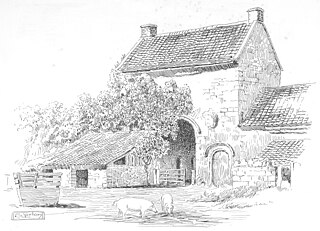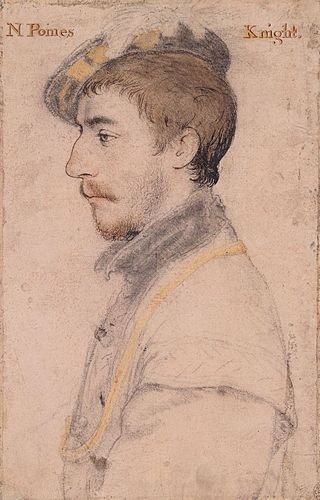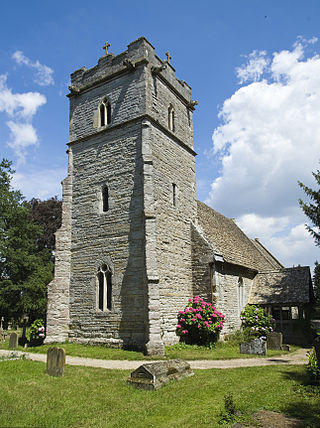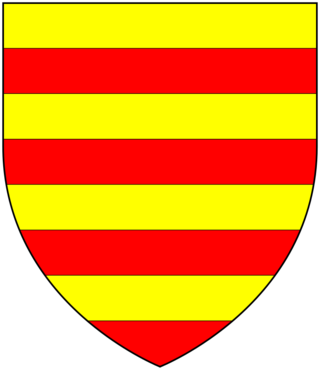
Thornbury is a market town and civil parish in the South Gloucestershire unitary authority area of England, about 12 mi (19 km) north of Bristol. It had a population of 12,063 at the 2011 census. The population has risen to 14,496 in the 2021 census. Thornbury is a Britain in Bloom award-winning town, with its own competition: Thornbury in Bloom. The earliest documentary evidence of a village at "Thornbyrig" dates from the end of the 9th century. The Domesday Book of 1086 noted a manor of "Turneberie" belonging to William the Conqueror’s consort, Matilda of Flanders, with 104 residents.

Anthony Woodville, 2nd Earl Rivers, was an English nobleman, courtier, bibliophile and writer. He was the brother of Queen Elizabeth Woodville who married King Edward IV. He was one of the leading members of the Woodville family, which came to prominence during the reign of King Edward IV. After Edward's death, he was arrested and then executed by the Duke of Gloucester as part of a power struggle between Richard and the Woodvilles. His English translation of The Dictes and Sayings of the Philosophers is one of the first books printed in England.

Olveston is a small village and larger parish in South Gloucestershire, England. The parish comprises the villages of Olveston and Tockington, and the hamlets of Old Down, Ingst and Awkley. The civil parish population at the 2011 census was 2,033. Alveston became a separate church parish in 1846. The district has been inhabited since the Stone Age, and the salt marshes that made up almost half of the parish, were progressively drained in Roman and Saxon times. A sea wall was constructed at the same time to prevent flooding from the nearby estuary of the River Severn.

Iron Acton is a village, civil parish and former manor in South Gloucestershire, England. The village is about 2 miles (3 km) west of Yate and about 9 miles (14 km) northeast of the centre of Bristol. The B4058 road used to pass through the village but now by-passes it just to the north.

Frampton Cotterell is a village and civil parish in South Gloucestershire, England, on the River Frome. The village is contiguous with Winterbourne to the south-west and Coalpit Heath to the east. The parish borders Iron Acton to the north and Westerleigh to the south-east, the large town of Yate is 2 miles away. The village is 8 miles north-east of Bristol. The population of the village together with the adjoining village of Winterbourne was 14,694 in 2011. The population of the parish alone was 6,520 at the 2011 census.

Hill is a village and civil parish in South Gloucestershire, England, midway between the towns of Thornbury in South Gloucestershire and Berkeley in Gloucestershire. The parish stretches from the banks of the River Severn to an outcrop of the Cotswolds escarpment. At the 2001 census, it had a population of 114. Hill is approximately 5 miles from the M5 motorway which links to Gloucester, Cheltenham and Bristol.

Kingswood Abbey was a Cistercian abbey, located in the village of Kingswood near Wotton-under-Edge, Gloucestershire, England. The abbey was demolished during the Dissolution of the Monasteries, and all that remains is the gatehouse, a Grade 1 listed building. Through the gatehouse arch are a few houses and the small village primary school of Kingswood.
This is a list of Sheriffs and High Sheriffs of Gloucestershire, who should not be confused with the Sheriffs of the City of Gloucester.

St Mark's Church is an ancient church on the north-east side of College Green, Bristol, England, built c. 1230. Better known to mediaeval and Tudor historians as the Gaunt's Chapel, it has also been known within Bristol since 1722 as the Lord Mayor's Chapel. It is one of only two churches in England privately owned and used for worship by a city corporation. The other is St Lawrence Jewry, London. It stands opposite St Augustine's Abbey, founded by a member of the Berkeley family of nearby Berkeley Castle, from which it was originally separated by the Abbey's burial ground, now called College Green. It was built as the chapel to the adjacent Gaunt's Hospital, now demolished, founded in 1220. Except for the west front, the church has been enclosed by later adjacent buildings, although the tower is still visible. The church contains some fine late gothic features and a collection of continental stained glass. It is designated by Historic England as a grade I listed building.

Newark Park is a Grade I listed country house of Tudor origins located near the village of Ozleworth, Wotton-under-Edge, Gloucestershire. The house sits in an estate of 700 acres (2.8 km2) at the southern end of the Cotswold escarpment with views down the Severn Valley to the Severn Estuary. The house and estate have been in the care of the National Trust since 1946.

Sir Nicholas Poyntz was a prominent English courtier during the latter part of Henry VIII's reign. There is a portrait drawing by Hans Holbein the Younger in the Royal Collection and an oil portrait after the same artist based on the drawing in the National Portrait Gallery, London. One further portrait also exists after Holbein.

Alderley House is a mid-19th century 23,843 square feet (2,215.1 m2) Grade II listed country house designed by Lewis Vulliamy and built for Robert Blagden Hale in the Cotswold village of Alderley, near Wotton-under-Edge in Gloucestershire, England. It was built on the site of The Lower House, a 17-century manor house built by Sir Matthew Hale, a lawyer. The house is situated immediately to the southwest of St Kenelm's Church. In 2009 it was sold to an American oil executive who restored the house as a private home after 70 years serving as a preparatory school, Rose Hill School.
Sir Robert Pointz or Poyntz (1588–1665) was an English landowner and politician. He sat in the House of Commons for Gloucestershire, between 1626 and 1629.
Sir John Pointz or Poyntz was an English landowner and politician who sat in the House of Commons in 1593. He is perhaps best remembered as the maternal grandfather of James Butler, 1st Duke of Ormond.

John Poyntz was an English courtier and politician, Member of Parliament for Devizes in 1529.

Hasfield is a civil parish in Gloucestershire, England, and lies six miles (9.7 km) south-west of Tewkesbury and seven miles (11 km) north of Gloucester. It is situated on the west bank of the River Severn; as much of its land resides below the 50-foot contour, it is subject to regular flooding. Hasfield is represented by the county councillor for Severn Vale division and the two borough councillors for Highnam with Haw Bridge ward on Tewkesbury Borough Council.

Eva Dorothy Brown was a campaigner who was recognised with an MBE (1988) for her work to save buildings in Bristol and in the Avon area.
The historic manor of Iron Acton was a manor centred on the village of Iron Acton in Gloucestershire, England, situated about 9 miles (14 km) north-east of the centre of the City of Bristol. The manor house, known as Acton Court is a Tudor building which survives today, situated at some distance from the village and parish church of St Michael. It was long the principal seat of the prominent Poyntz family, lords of the manor, whose manorial chapel is contained within the parish church.

Sir Robert Poyntz, lord of the manor of Iron Acton in Gloucestershire, was a supporter of the future King Henry VII at the Battle of Bosworth in 1485. He was buried in the Gaunt's Chapel, Bristol, in the magnificent "Chapel of Jesus", a chantry chapel built by him.
Anne Poyntz was an English courtier who owned a significant collection of jewellery.


















